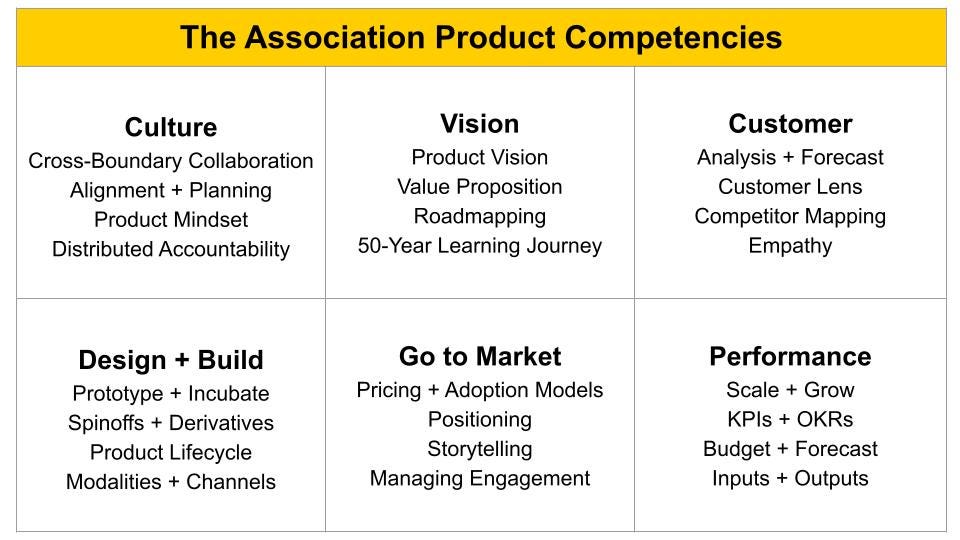Mapping Progress
How a Maturity Model Can Create a Path for Strategic Growth
Summary
This is an article on how to use a maturity model. We will introduce the concept, discuss why it’s important for associations, and cover the product community maturity model, which has been designed for any association that creates, delivers, and wants to get better at producing value of any kind – events, publications, courses, etc.
A maturity model is a qualitative tool to assess and improve the capabilities and performance of an association. It helps associations anchor their current state, chart an ideal state, and identify gaps in order to create a path for strategic growth.

The Product Community is a product development learning community designed specifically for associations.
What is a Maturity Model?
“It’s not the strongest species that survive, nor the most intelligent, but the most responsive to change.”
Charles Darwin
A maturity model is a way to assess and improve the capabilities and performance of an association or a particular aspect of it, such as a process, technology, department, or strategy. It can also be used as a companion to an association’s strategic plan.
A maturity model is like a roadmap that outlines different stages or levels of maturity that an association can progress through. Each level represents a higher degree of effectiveness, efficiency, or capability.
The model typically consists of a set of criteria or characteristics that define each level.
Maturity models can be created for nearly anything an association does. For instance, here is a simplified maturity model (without descriptions) designed for a digital transformation.
When using a maturity model, an association assesses its current state and determines which level it currently falls into. Based on this assessment, it can identify the gaps and deficiencies that need to be addressed to move to the next level. See my article on ideal state outcomes for how to assess current and future states.
An association can then set goals and work on implementing changes and improvements to advance to a higher level of maturity.
As the association progresses through the levels, it gradually improves its processes, practices, and overall performance. Depending on the depth of its construction, a maturity model can provide guidance on what needs to be done at each level, giving an association a clear path to follow.
Maturity models are not one-size-fits-all. They can be used with many other strategy tools to paint a fuller picture. However, the model plays a synthesis role as it helps associations understand where they are and where they want to be while providing a structured approach to reaching a shared destination.
Why Associations Should Use Maturity Models
“Immature leaders act; mature leaders think, act, and reflect.”
Michael Holland
There are tools abound to guide associations in their journey to growth. We cover many of them in this newsletter. Some of the well-trod tools – namely SWOT – are overused and given too much credence, especially as they only tell part of the story.
We recommend using a maturity model in connection with other tools and resources, several of which are covered in my article on association performance metrics.
Associations can use a maturity model in lots of ways:
To anchor a shared understanding of the current state based on a number of core competencies
To envision a shared ideal state
To identify gaps + create goals
To build community + connect change enthusiasts
To develop a vision + incentivize shared action
To build momentum + demonstrate progress
To foster alignment + coordination
To tell a compelling story about progress
To enhance capabilities
To get better at building products
In the product community, we guide and advise associations and nonprofits on how to design and develop new value for your community.
We do this by leveraging existing value and by using a product development framework which takes the proven-practices from the world of product development and applies them to the rich, collaborative world of professional associations.
When crafting a vision, developing a strategy, building a new product, or embarking on a major project, I strongly believe in shooting for the moon. However, in order to succeed at our aspirations, we need to ensure we can execute responsibly.
In this way, progress is much more incremental in nature. This is how maturity models work. They are pragmatic tools that force us to focus as we wind our way to the ideal state.
As part of this newsletter, I have written about related topics that put the product community maturity model into context:
The association product competencies, which anchors the product community maturity model.
Measuring the performance of association products, which provides an overview of various assessment tools and puts the maturity model in a broader context.
Finding your north star, which addresses how to develop and utilize an ideal state outcome, a companion tool to the product community maturity model.
I now want to cover the maturity model that I developed for the product community, which is based on the six association product competencies.
The Association Product Maturity Model
“Without change there is no innovation, creativity, or incentive for improvement. Those who initiate change will have a better opportunity to manage the change that is inevitable.”
William Pollard
The product community is a product development learning community designed specifically for associations.
The product community is a competency-based program. The competencies are the through-line for progress and a spine for skill-building in core areas of product development.
Gauging competence helps product community participants achieve clarity of mission while ensuring learners demonstrably gain critical knowledge and skill in the product community competencies.
Assessing product performance is an important part of the product community fabric, integrated at all stages of the experience: in creation of expectations, development of goals and outcomes, measurement of learning, and tangibly connected to growth, impact, and product performance.
Whether you are putting on an event, compiling and distributing a journal, creating a game, or offering a course you can utilize the association product competencies as a repeatable framework to better understand your members, create new value, and measure impact.
Culture — Products drive trust
Vision — Products are anticipatory
Customer — Products solve problems
Design + Build — Products are optimized
Go to Market — Products are in demand
Performance — Products are indispensable
As a maturity model gauges an association’s maturity in a number of competencies, it is best utilized as (1) an integrative tool to help align practice and progress, but also as a (2) useful tool to help create pathways or longitudinal learning journeys.
How it Works In Practice
“Success works as a cycle – growth and contraction, balancing and unbalancing – all while you’re encountering hurdles that get higher and higher over time.”
Julien Smith
A maturity model helps assess, plan, and improve their capabilities over time, providing a framework for continuous growth and development. It can also help an association understand its limitations or gaps, develop a vision, or set strategic goals.
Maturity models are structured as a series of levels of effectiveness. Associations (or teams) will typically pass through levels in sequence as they become more capable.
This particular model (represented in the above rubric) is generalized. That is, the six competencies typically comprise most association product strategies.
Working with a maturity model begins with a general self-assessment. This can be accomplished by simply identifying (and circling) relevant levels for each competency (each row in the above maturity model).
It is common for some respondent choices to be sporadic or inconsistent (you will want to circle more than one box in a row). This is normal.
Try to select the best choice and please reflect any identified contradictions during the discussion / report-out.
Once you've determined your level for each competency, you can prioritize the capabilities your organization needs to get to where it wants to be.
As a longitudinal tool, the maturity model can be used overtime, for instance, as a report card for a strategic plan or key strategic initiative. As you can see here, the gray circles denote the current state and the yellow circles denote how a particular association has become more optimized over time.
Here are some ways associations can move from the left (current state) to a the right (ideal state):
Commit to a set of core competencies that complement and help synthesize the association’s mission, vision, and values.
Apply the core competencies across your product portfolio so you can link – and start to compare performance – across your offerings. See this article to learn about product portfolios.
Invest in capabilities to help focus your staff around the competencies and/or key areas of growth for your association. Likewise, position your volunteers for focused alignment and maximum impact.
Identify the current competency in which you rate the highest and use this to anchor progress in ones you are weaker.
Choose the three most important competencies to your association and focus your attention here. Link these three most important competencies to your biggest money makers (i.e. annual event or membership). Use the model to set aspirational goals.
Use the maturity to create measurable, longitudinal targets.
Reduce friction for how your association attracts and retains members. This can be accomplished by creating integrated and effective workflows for joining, buying, engaging, or contributing. This, of course, will take an investment in data governance and technology integration.
Use the maturity model as a way to create focus, chart progress, and identify areas of investment with the board and key committees like membership or professional development (learning).
A Common Tool to Guide Strategic Growth
“Do not wait. The time will never be just right. Start where you stand and work with whatever tools you have at your command and better tools will be found as you go along.”
George Herbert
Maturity models are highly flexible tools. They can be used to position your association for nearly any change initiative.
They are most successful if anchored by a finite set of agreed-upon competencies and used in conjunction with other tools that can inform level jumping. This way, we can map progress over time.
If you are developing a strategic plan or building a new product, we recommend the product community maturity model. Why?
Because a maturity model can guide an association on a journey to strategic growth. In addition to anchoring the current state, identifying the ideal state, and teasing out gaps, it can foster rich collaboration, aligned action, and successful outcomes.
Product-led growth fuels connection. Join the product community and flip your destiny.
About the Author
James Young is founder and chief learning officer of the product community®. Jim is an engaging trainer and leading thinker in the worlds of associations, learning communities, and product development. Prior to starting the product community®, Jim served as Chief Learning Officer at both the American College of Chest Physicians and the Society of College and University Planning.
Please contact me for a conversation: james@productcommunity.us.






